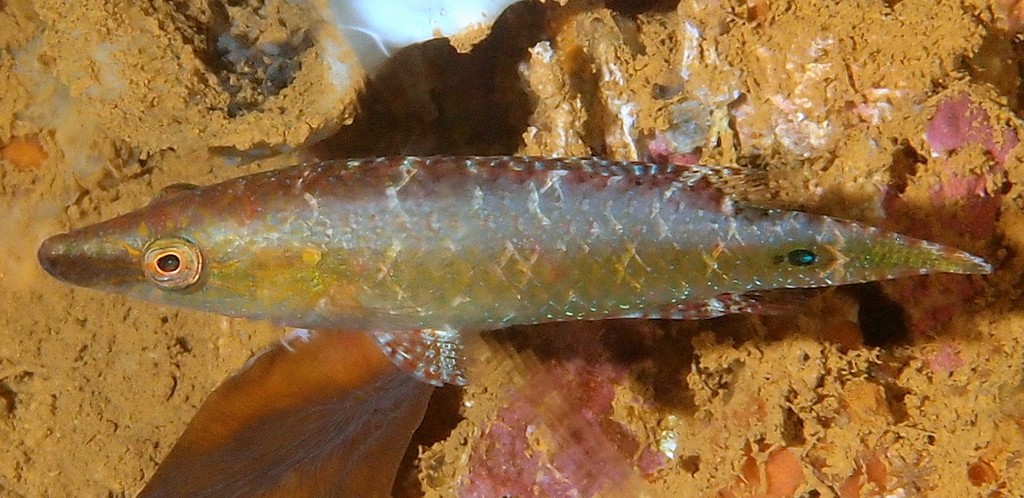OXYCHEILINUS CELEBICUS - (BLEEKER, 1853)
Actinopterygii (Gigaclass) > Actinopteri (Class) > Teleostei (Subclass) > Perciformes (Order) > Labroidei (Suborder) > Labridae (Family) > Oxycheilinus (Genus)
Labre des Célèbes, Labre Maori des Célèbes, Slender maori wrasse, Celebes maori wrasse, Celebes maoriwrasse, Celebes maori-wrasse, Celebes wrasse, Eared maori wrasse, Slender maori, Mochino-uo, Hananaga-mochino-uo, ハナナガモチノウオ, 西里伯斯唇魚, 尖吻唇魚,
Synonymes
Cheilinus celebicus (Bleeker, 1853)
Cheilinus hoevenii (Bleeker, 1862)
Cheilinus oxyrhynchus (Bleeker, 1862)
---------------------
Description
Dorsal spines (total): 9; Dorsal soft rays (total): 10; Anal spines: 3; Anal soft rays: 8; Pectoral fin rays: 12; Lateral line scales: 15-16 + 7; Gill rakers: 6-8 + 10-13. Anterior tip of lower jaw ending anterior to tip of upper jaw. Lateral line interrupted below posterior portion of dorsal-fin base. Scaly sheath extending onto dorsal and anal fins; Predorsal scales 6 reaching forward to vertical at center of eye; Cheek scales reaching just anterior to forward extent of orbit; Subopercular scales extending anteriorly to vertical at center of eye. Pelvic fins short, not reaching anus. Max. length: 24.0 cm TL. Depth range: 3 - 40 m, usually: 5 - 30 m.
Color
Juveniles have a black ocellus on the caudal-fin base.
Females are densely mottled with pale red and dark brown blotches, often squarish blotches interspersed with pale bars along the midside forming a broad band that darkens towards the rear, and a small white spot on the upper rear edge of the gill cover.
Males are mottled reddish to brownish with pale flecks on the body scales, orange lines radiating from the eye, a small blue spot on the front of the dorsal fin, and a dark blotch on the caudal peduncle.
Etymology
Oxycheilinus: from Greek, oxys = sharp + from Greek, cheilos = lip.
celebicus: named from the type locality.
Original description: Cheilinus celebicus Bleeker, 1853 - Type locality: Makassar, Sulawesi (formerly Celebes), Indonesia.
Distribution
Eastern Indian Ocean, western Pacific: eastern Andaman Sea east to Marshall Islands and New Ireland (Papua New Guinea), north to Japan, south to Australia and New Caledonia.
Biology
Inhabits coral-rich areas of protected reefs, with a rich mix of soft and brittle hard corals and other invertebrates. Protogynous hermaphrodites, changing sex from female to male during their life cycle. Aquarium fish.
Similar species
Cheilinus oxycephalus (Bleeker, 1853) - Reported from New Caledonia - Link to the species (here). The concave head profile of Oxycheilinus celebicus is similar to that of Cheilinus oxycephalus, but its coloration is distinctive. Brownish red, mottled with small whitish spots; Dark brown spot anteriorly on each side of upper lip; Two dark lines diverging from the eye; Dark brown spot on the first two dorsal membranes. Deep-bodied for genus, and snout pointed.
Last update: 6, August 2023
Labre des Célèbes, Labre Maori des Célèbes, Slender maori wrasse, Celebes maori wrasse, Celebes maoriwrasse, Celebes maori-wrasse, Celebes wrasse, Eared maori wrasse, Slender maori, Mochino-uo, Hananaga-mochino-uo, ハナナガモチノウオ, 西里伯斯唇魚, 尖吻唇魚,
Synonymes
Cheilinus celebicus (Bleeker, 1853)
Cheilinus hoevenii (Bleeker, 1862)
Cheilinus oxyrhynchus (Bleeker, 1862)
---------------------
Description
Dorsal spines (total): 9; Dorsal soft rays (total): 10; Anal spines: 3; Anal soft rays: 8; Pectoral fin rays: 12; Lateral line scales: 15-16 + 7; Gill rakers: 6-8 + 10-13. Anterior tip of lower jaw ending anterior to tip of upper jaw. Lateral line interrupted below posterior portion of dorsal-fin base. Scaly sheath extending onto dorsal and anal fins; Predorsal scales 6 reaching forward to vertical at center of eye; Cheek scales reaching just anterior to forward extent of orbit; Subopercular scales extending anteriorly to vertical at center of eye. Pelvic fins short, not reaching anus. Max. length: 24.0 cm TL. Depth range: 3 - 40 m, usually: 5 - 30 m.
Color
Juveniles have a black ocellus on the caudal-fin base.
Females are densely mottled with pale red and dark brown blotches, often squarish blotches interspersed with pale bars along the midside forming a broad band that darkens towards the rear, and a small white spot on the upper rear edge of the gill cover.
Males are mottled reddish to brownish with pale flecks on the body scales, orange lines radiating from the eye, a small blue spot on the front of the dorsal fin, and a dark blotch on the caudal peduncle.
Etymology
Oxycheilinus: from Greek, oxys = sharp + from Greek, cheilos = lip.
celebicus: named from the type locality.
Original description: Cheilinus celebicus Bleeker, 1853 - Type locality: Makassar, Sulawesi (formerly Celebes), Indonesia.
Distribution
Eastern Indian Ocean, western Pacific: eastern Andaman Sea east to Marshall Islands and New Ireland (Papua New Guinea), north to Japan, south to Australia and New Caledonia.
Biology
Inhabits coral-rich areas of protected reefs, with a rich mix of soft and brittle hard corals and other invertebrates. Protogynous hermaphrodites, changing sex from female to male during their life cycle. Aquarium fish.
Similar species
Cheilinus oxycephalus (Bleeker, 1853) - Reported from New Caledonia - Link to the species (here). The concave head profile of Oxycheilinus celebicus is similar to that of Cheilinus oxycephalus, but its coloration is distinctive. Brownish red, mottled with small whitish spots; Dark brown spot anteriorly on each side of upper lip; Two dark lines diverging from the eye; Dark brown spot on the first two dorsal membranes. Deep-bodied for genus, and snout pointed.
Last update: 6, August 2023
